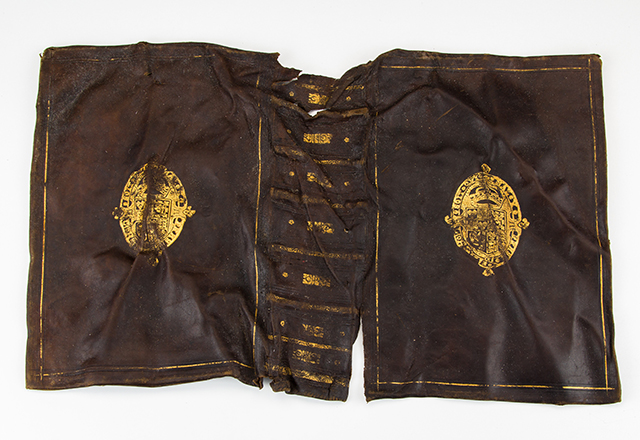 In the Palmwood Wreck, two ship chests with at least 32 bookbindings were found. These were mainly large leather bookbindings, covered with diverse (gilded) decorations. Various seals from other books were also found. This may have once been a large library of expensive books. One of the most remarkable bindings was a calf leather bookbinding with royal stamp.
In the Palmwood Wreck, two ship chests with at least 32 bookbindings were found. These were mainly large leather bookbindings, covered with diverse (gilded) decorations. Various seals from other books were also found. This may have once been a large library of expensive books. One of the most remarkable bindings was a calf leather bookbinding with royal stamp.
Kings of England, Ireland and Scotland
The stamp represents the coat of arms of the Scottish royal family Stuart. The Stuart family had been providing the kings of Scotland since the Middle Ages. At the start of the seventeenth century, King James VI became the king of Scotland and also king of England and Ireland. All of these countries are portrayed in the four parts of the crowned coat of arms. From above: the upright lion of Scotland, four smaller shields of the English crown with twice three English lions and twice three French lilies, the harp of Ireland and finally the shield of England again. The traditional French motto of the English Order of the Garter can also be read: Honi soit qui mal y pense (shame on anyone who things evil of it).
Speculations
Thanks to the easily recognizable coat of arms of the English royal family, a link was soon made between the Palmwood Wreck and England. Could the whole collection of expensive articles and clothes originate from England? Did this book come from the royal library in London? And would the Dress have been worn at the Stuart court?
Trade binding
Research into the bookbinding shows that this is an example of ‘trade binding’: a book cover for private sale. Two books have been found in libraries in Cambridge with the same stamp. As with this book cover, the binding was most probably made in London around 1620. There is no reason to assume that they were ever in the English court.
Book collector
Further research into the rest of the bookbindings casts even more doubt on the origin of the ship. The library collection is very international. Alongside the English binding, there have also been bookbindings identified from France, Flanders, Germany, Amsterdam and even Poland. Many expensive bindings were made in the sixteenth century and some at the start of the seventeenth century. Could this be an antique collection of books, from a very wealthy book lover?
NB: Research continues to be conducted into the collection. For this reason, this article may contain obsolete information or outdated insights.

